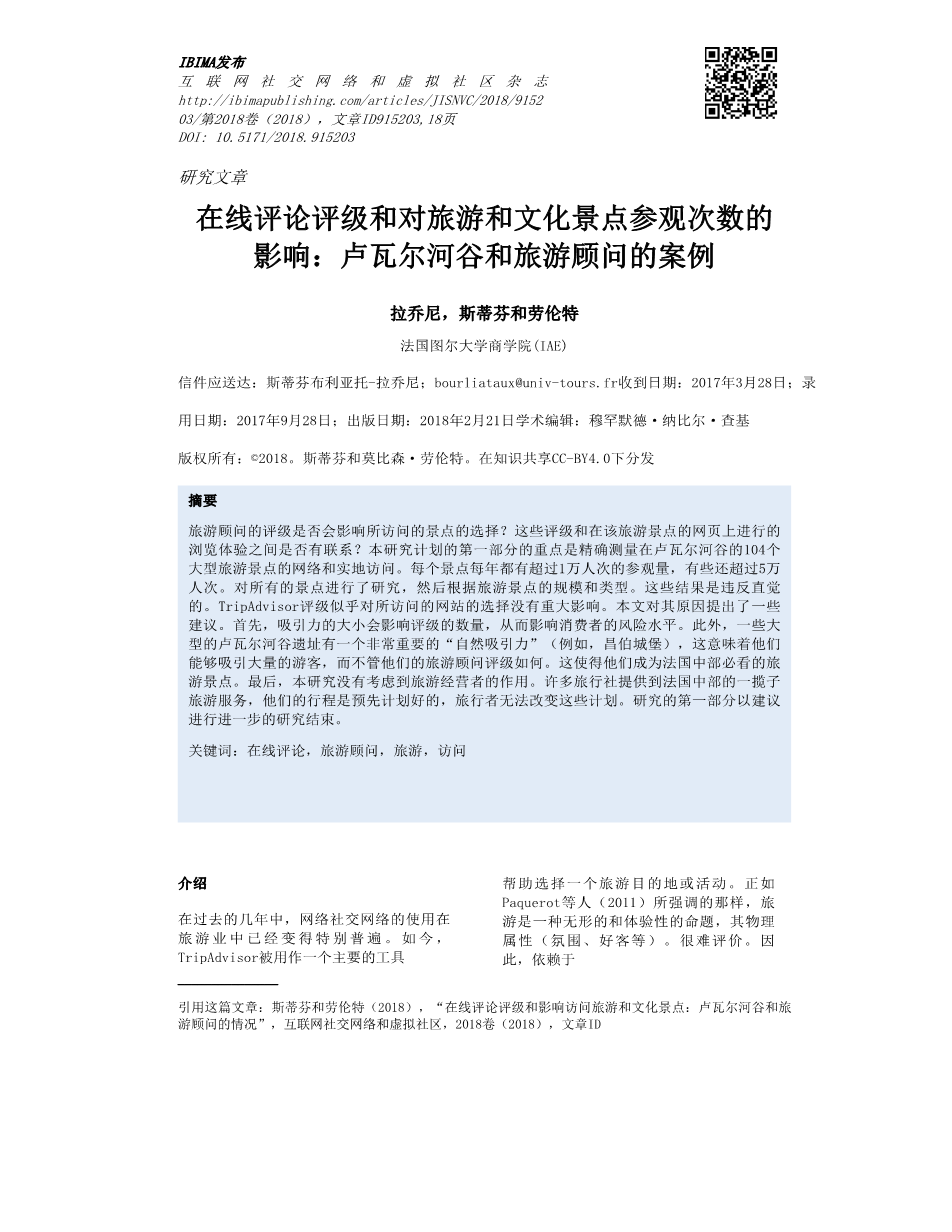IBIMA Publishing
Journal of Internet Social Networking amp; Virtual Communities http://ibimapublishing.com/articles/JISNVC/2018/915203/ Vol. 2018 (2018), Article ID 915203, 18 pages
DOI: 10.5171/2018.915203
Research Article
Online Review Ratings and the Impact on the Number of Visits to a Tourist and Cultural Attraction: the case of the Loire Valley and TripAdvisor
Bourliataux-Lajoinie Steacute;phane and Maubisson Laurent
University business school (IAE) of Tours, France
Correspondence should be addressed to: Stephane Bourliataux-Lajoinie; bourliataux@univ-tours.fr Received date: 28 March 2017; Accepted date: 28 September 2017; Published date: 21 February 2018 Academic Editor: Mohammed Nabil Chaki
Copyright copy; 2018. Bourliataux-Lajoinie Steacute;phane and Maubisson Laurent. Distributed under Creative Commons CC-BY 4.0
Abstract
Do TripAdvisor ratings affect the choice of attraction visited? Is there a link between these ratings and browsing experience on the tourist attractionrsquo;s web page? The first part of this research programme focuses on precisely measuring web and physical visits of 104 large tourist attractions in the Loire Valley. Each attraction has over 10,000 annual visits and some exceed 50,000. A study was made of all the attractions, and then according to the size and type of tourist attraction. The results are counter-intuitive. TripAdvisor ratings do not seem to have a significant impact on the choice of the site visited. A number of suggestions are put forward as to the reason for this. First, an attractionrsquo;s size impacts the number of ratings and therefore the level of risk for a consumer. Further, some large Loire Valley sites have a very important “natural attraction” (the Chateau de Chambor, for example), which means they are able to attract a large number of visitors irrespective of their TripAdvisor rating. This makes them must-see tourist attractions in central France. Finally, this study did not take into account the role of tour operators. Many tour operators offer package tours to central France, their itinerary is pre-planned and the traveller is unable to alter these. The first part of the research ends with a recommendation that further study be carried out.
Keywords: online reviews, TripAdvisor, tourism, visits
Introduction
Over the past few years, the use of online social networks has become particularly commonplace in the tourism sector. These days, TripAdvisor is used as a major tool in
_______________
helping select a tourist destination or activity. As highlighted by Paquerot et al. (2011), tourism is an intangible and experiential proposition whose physical attributes (atmosphere, hospitality, etc.) are difficult to rate. Thus, reliance on the
Cite this Article as: Bourliataux-Lajoinie Steacute;phane and Maubisson Laurent (2018), ' Online Review Ratings and the Impact on the Number of Visits to a Tourist and Cultural Attraction: the case of the Loire Valley and TripAdvisor', Journal of Internet Social Networking amp; Virtual Communities, Vol. 2018 (2018), Article ID
opinion of other consumers has become more and more common when preparing a trip or visit to a tourist attraction. In fact, the number of people consulting online review platforms when selecting a tourist destination is growing (Buhalis and Law, 2008). According to Filieri et al. (2015),
200 million travellers will consult platforms like TripAdvisor when planning a visit to a specific destination (travel, restaurant, hotel, etc.). Thus, better understanding the way these online ratings are perceived, and the way they impact behaviour, is an important issue for many tourist and cultural organisations, whose e- reputation may be affected by this type of platform (Hennig-Thurau et al. 2004 in Filieri et al. 2015).
Equally, this issue is even more important for tourist and cultural attractions located in areas that have a large number of historical attractions. This is true for the Loire Valley with its chateaus (e.g. Domaine National de Chambord), gardens (e.g. Villandry), museums (Museacute;e des Beaux- Arts), and theme parks (e.g. Zoo de Beauval). In such cases, a tourist will use a review platform before (to prepare the trip) and after his/her visit (Xiang and Gretzel, 2010).
A large number of marketing studies examine these online reviews. But oddly, the majority focus on the qualitative dimension of the reviews and primarily look at the written comments posted by Internet users. Some researchers even see
an opportunity to carry out netnographic studies (e.g. Beacute;deacute; and Massa, 2017). Other studies aim to better understand the strategies of hotels and tourist attractions when handling comments, and their relationship to users (generally also developing comprehensive qualitative approaches).
The purpose of this project is to approach the phenomenon differently by addressing a resolutely positivist and relatively simple issue: is there a significant link between (virtual and actual) visits to a tourist attraction and the number of “quantitative” reviews it receives on TripAdvisor?
In our view, this issue merits particular attention for two main reasons. The first is that these reviews, which correspond to 5- point Likert scale, are immediately visible on a TripAdvisor page (cf. inset 1). Accessing written comments involves scrolling down the page and careful reading.
The second is that the perceived credibility and quality of reviews relies, in part, on the number of reviews, so that it is easier to exclude what Munzel (2015) refers to as 'deceptive opinion spam'. There are more scale-t
剩余内容已隐藏,支付完成后下载完整资料


英语译文共 18 页,剩余内容已隐藏,支付完成后下载完整资料
资料编号:[589469],资料为PDF文档或Word文档,PDF文档可免费转换为Word
课题毕业论文、文献综述、任务书、外文翻译、程序设计、图纸设计等资料可联系客服协助查找。


